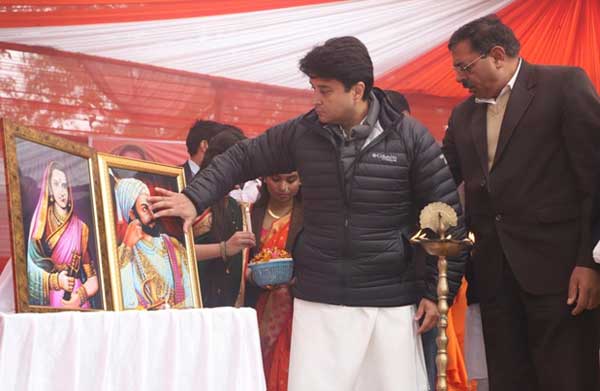Most of what is now the state of Haryana was part of the Subah of Delhi during the Maratha Empire. Haryana the state itself was constituted on November 1, 1966, as a result of the partition of the former state of United Punjab into two separate states Punjabi-speaking Punjab and Hindi-speaking Haryana and the hilly regions of Punjab were merged with Himachal Pradesh then a Union Territory.
It was in Panipat that Timurid Babur defeated Ibrahim Lodhi, Babur’s descendent Akbar defeated Hemu and Afghan emperor Ahmad Shah Abdali defeated the Marathas, but the victory of Abdali did not lead to the complete obliteration of Maratha power, rather a ray of hope remained in the form of Mahadji Scindia, who even though had been injured and lamed in the battlefield of Panipat, but yet through his commitment to unalloyed nationalism and persistent hard work, successfully reestablished Maratha power in most of the regions from which their authority had been decimated by the Afghans.
Scindia planted the Maratha flag on the ramparts of Red Fort in Delhi in 1771 description of which we get in contemporary Powadas (Marathi Valour Songs) and went on to defeat most of his opponents during his lifetime including the British at several places most prominently at Wadgaon. Union Minister of Civil Aviation and Steel and senior BJP leader Jyotiraditya Scindia is a descendant of the same Mahadji Scindia, in this article readers will get to know about historical connections between Scindia Marathas and Subahs of Lahore and Delhi.
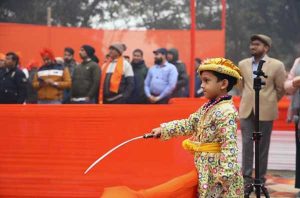 Three Scindias, namely,Dattaji, Sabaji and Jankoji helped spread Maratha power all the way upto Peshawar (refer to the works of Prof. V. S. Kadam, Dr. Ganda Singh, Prof Mast Ali Niazi, University of Nangarhar, Islamic Emirate of Afghanistan, Asst. Prof. Muhammad Ihsan Popalzai University of Laghman, and T. S. Shejwalkar), conquering Subahs of Delhi and Lahore (by the beginning of the year 1759, DattajiScindia and Jankoji Scindia were stationed at Lahore, as it seems clear from a letter, written on 21 March 1759 by Peshwe Balaji Bajirao to them).
Three Scindias, namely,Dattaji, Sabaji and Jankoji helped spread Maratha power all the way upto Peshawar (refer to the works of Prof. V. S. Kadam, Dr. Ganda Singh, Prof Mast Ali Niazi, University of Nangarhar, Islamic Emirate of Afghanistan, Asst. Prof. Muhammad Ihsan Popalzai University of Laghman, and T. S. Shejwalkar), conquering Subahs of Delhi and Lahore (by the beginning of the year 1759, DattajiScindia and Jankoji Scindia were stationed at Lahore, as it seems clear from a letter, written on 21 March 1759 by Peshwe Balaji Bajirao to them).
It was a cause of great concern for Afghans who were afraid that the aspirational Marathas may threaten Kabul and Kandahar soon if not stopped, when this fear was giving them sleepless nights, they received an invitation from some Indian Rajas and Nawab Najib-ud-Daulah of Rohilkhand to destroy the Maratha power. Ahmad Shah Abdali then decided to invade India. In the Third Battle of Panipat fought on 14 January 1761 and a day after that battle, 16 members of the Scindia clan attained martyrdom after displaying exceptional valour in fighting against the Afghans. Their cenotaphs still stand in the native village of Scindias Kanherkhed in Maharashtra, which is populated by several Shinde (in north India known as Sindhia/Scindia) families.
One of these martyrs was a young Jankojirao Scindia who is known as “Abhimanyu of the Marathas” he was just a teenager when he attained martyrdom. A great warrior he had conquered the Fort of Merta and surrounding areas in what is now Rajasthan, while his father Jayappadada Scindia defeated the combined armies of the rulers of Marwar (Jodhpur), Bikaner and Kishangarh establishing Scindia power in Rajputana.
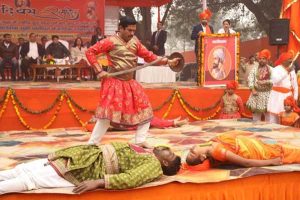 Another Scindia martyr was Tukojirao Scindia it was his grandson who sat on the Scindia throne as Daulatrao Scindia who controlled most parts of Subah of Delhi before British occupied it. But how did Scindias win Subahs of Delhi and Lahore?
Another Scindia martyr was Tukojirao Scindia it was his grandson who sat on the Scindia throne as Daulatrao Scindia who controlled most parts of Subah of Delhi before British occupied it. But how did Scindias win Subahs of Delhi and Lahore?
Just ten years after the battle of Panipat, Mahadji Scindia became de facto supreme authority in the imperial capital Delhi. Then he turned his eyes to other areas of Subahs of Delhi and Lahore. As per Professor S.C. Mittal in his book “Haryana, A Historical Perspective”, published by Atlantic Publishers & Distributors, what is now Haryana was divided into a number of small principalities. Northern Haryana including Ambala, Karnal and Jind had been under the Sikh chiefs. Najaf Quli Khan had occupied the territories of Rewari, Narnaul, Gurgaon, Jhajjar and Rohtak. He posed to be an independent ruler, with Gokalgarh as his capital. The north-east territory of what is now Haryana was under the Bhatis, they had in their possession Fatehabad, Rania and Sirsa. So practically the whole of what is now Haryana that was then mostly part of Subah of Delhi was independent.
Maharaja Mahadji Scindia defeated his enemies and conquered these regions. Scindia divided the territories of what is now Haryana into four parts, Delhi that included the Mughal’s palace and family and the surrounding area of Haryana; Panipat that constituted the present districts of Karnal, Sonipat, Ambala and Kurukshetra; Hissar that included Hissar and some parts of present district; Mewat that included Gurgaon, Rewari, Narnaul and Mahendragarh. Mahadji Scindia made Ambuji Ingle as faujdar of Sonipat, 106 villages of Sonipat and Panipat Provinces were governed by Mahadji Scindia’s daughter Balabai Shitole née Scindia and after Mahadji Scindia passed away his adopted son Maharaja Daulatrao Scindia ruled Subah of Delhi, in November, 1794 he appointed Lakhwa Dada his viceroy of the north in place of Gopal Bhau.
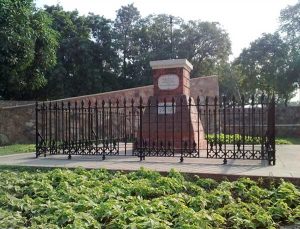 Later Lakha Dada appointed his deputy Nana Rao at Karnal and allowed him to collect the revenue from the cis Sutlej country. Scindias lost almost all of the then Subah of Lahore with the rise of the mighty Sikh Empire under the great Maharaja Ranjit Singh.
Later Lakha Dada appointed his deputy Nana Rao at Karnal and allowed him to collect the revenue from the cis Sutlej country. Scindias lost almost all of the then Subah of Lahore with the rise of the mighty Sikh Empire under the great Maharaja Ranjit Singh.
Scindias controlled the administration of Subah of Delhi till 1803. A.D. Scindias and other Marathas fought bravely in the Anglo-Maratha war in September, 1803. During this Anglo-Maratha war, certain rulers showed their allegiance to the British against Scindias. With the battle of Laswari fought near Alwar now in Rajasthan Scindias lost a huge region of northern India. Col George B. Malleson wrote “Battle of Laswari brought to the ground, crumbled and trampled in the dust all the dreams of Madhaji Sindia. From its effects the great Maratha family never recovered!” (References: Michael Edwardes in his book “The King of the World : The Life and Times of Shah Alam”, 1970 published by Taplinger Pub. Co and Professor S.C. Mittal in his book “Haryana, A Historical Perspective”, published by Atlantic Publishers & Distributors).
After fighting the British in different areas of India, Maharaja Daulatrao Scindia was finally defeated by them due to treachery of his European officers (refer to “Struggle for Empire: Anglo-Maratha Wars 1679-1818” book by Col. Anil A. Athale) and on December 30, 1803, he ceded the territory of what is now Haryana to the victorious British through the treaty of Surji Anjangaon. This territory was included in the Presidency of Bengal with a Resident at Delhi to administer it. British divided the territory of what is now Haryana and gave many of it’s territories to their allies in their battles against Scindias, (References: S.C. Mittal: Haryana, A Historical Perspective, 1986, Buddha Parkash, Hariyana Through the Ages, J.N. Sarkar, The Fall of Mughal Empire, Vol. IV, Hissar District and Loharu State Gazetteer (Loharu State), and 1915, pp. 2-3; Alwar District Gazetteer, 1968, p.65).
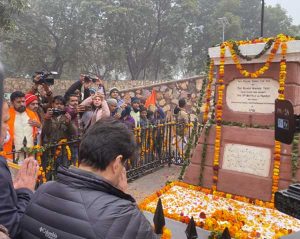 After losing Subah of Delhi Maharaja Daulatrao Scindia started distrusting his European officers who had backstabbed him in his wars against the British, he removed several of them from his army. Though Scindia influence was over in what is now Haryana and British rule had begun, yet the Scindias continue to look at Panipat emotionally remembering the sacrifice of their ancestors and other Marathas.
After losing Subah of Delhi Maharaja Daulatrao Scindia started distrusting his European officers who had backstabbed him in his wars against the British, he removed several of them from his army. Though Scindia influence was over in what is now Haryana and British rule had begun, yet the Scindias continue to look at Panipat emotionally remembering the sacrifice of their ancestors and other Marathas.
This year again the valour and sacrifice of the Marathas was remembered at Panipat on the anniversary of the Third Battle of Panipat on 14 January, in the presence of several esteemed guests including the descendant of those Scindias who had contributed significantly in the history of Haryana, Union Minister of Civil Aviation and Steel Mr. Jyotiraditya M. Scindia.
Honourable Prime Minister Shri. Narendra Modi says “Ek Bharat Shresth Bharat” the author wishes may this event strengthen the friendship of people of Punjab. Haryana, Maharashtra, Delhi and Madhya Pradesh even more and help us spread the knowledge about the valour of great warriors of India. Wherever you are dear readers do pay tribute to the brave Maratha martyrs who lost their lives in the Third Battle of Panipat.




